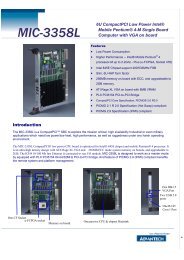industrial wireless book special edition - Networking ...
industrial wireless book special edition - Networking ...
industrial wireless book special edition - Networking ...
You also want an ePaper? Increase the reach of your titles
YUMPU automatically turns print PDFs into web optimized ePapers that Google loves.
Transportation<br />
> CAR TO ROADSIDE COMMUNICATION<br />
USING IEEE 802.11P TECHNOLOGY<br />
multi-hop networking of RSUs and the creation<br />
of a corresponding service platform. The organisation<br />
is looking to jointly develop the storage<br />
of up-to-date information in the RSU network<br />
(such as service station data), analysis and<br />
display of the processed data on the OBU<br />
(aggregation and filtering) and global<br />
networking (Internet).<br />
To ensure reliable implementation of such<br />
concepts, an end-to-end simulation environment<br />
comprising traffic and network simulators<br />
is required. These will allow simulation of<br />
processes such as the intelligent aggregation<br />
and filtering of the data, or the routing<br />
algorithms in mesh networks with mixed architectures<br />
(stationary and ad hoc) and their<br />
impact on network loads. The information<br />
forwarding process and the driving strategies<br />
can then be analysed to determine their effectiveness.<br />
Such general frameworks are currently<br />
being developed.<br />
Network continuity, an increasingly important<br />
issue, is also being improved. This applies not<br />
only to the continuity of multimodal navigation<br />
with up-to-date data, but also office-to-car<br />
continuity, in which the workplace shifts from<br />
the office to the car and is then adapted to<br />
the vehicle environment.<br />
Participation<br />
To ensure interoperability between automobile<br />
manufacturers, all of the communication protocols<br />
and security concepts must be standardised.<br />
Various committees, including IEEE, C2C CC, ETSI<br />
and ISO, are working together to develop such<br />
standards. As member of the Car to Car<br />
Communication Consortium (C2CCC) Fraunhofer<br />
ESK is participating in this process.<br />
Other current topics are new network technologies,<br />
software methodology, networks<br />
embedded systems, car-to-environment<br />
networks, electro mobility, <strong>wireless</strong> communication<br />
and sensor networks as well as mobile<br />
expert systems.<br />
Josef Jiru is a research fellow at Fraunhofer ESK in<br />
Munich, Germany.<br />
WLAN: the future for railway<br />
communications networks?<br />
Technologies underlying train communications systems have advanced<br />
little since the first ‘modern’ rail systems were established 200 years ago.<br />
However, the latest <strong>wireless</strong> data technologies now enable the creation of<br />
advanced train communications systems. WLANs offer an optimal<br />
combination of bandwidth and cost-effectiveness for such operations, and<br />
Gigabit bandwidth enables real-time performance for passenger comfort<br />
and security. The future of railway communications is coming, and<br />
operators need to be ready, says Paul Hsu.<br />
DRIVEN BY CHANGING market expectations,<br />
bandwidth, response time and advancing technologies,<br />
train communications technology is<br />
in the midst of a highly significant transition.<br />
Train communications systems now must do<br />
more than ever before. The railway applications<br />
Max Data Rate<br />
of today, tomorrow, and beyond demand more<br />
bandwidth, a faster real-time response time and<br />
more reliability from their communications<br />
networks, be they intra-train, train-to-ground,<br />
or trackside networks.<br />
Typical train networks include the Ethernet<br />
train backbone, ground-to-train communications<br />
and onboard IP video surveillance.<br />
Response time<br />
Traditionally, train control relied on human<br />
operators being given directions through some<br />
combination of radio, visual signals and track<br />
circuits, but the response time is slow, so for<br />
safety reasons, tracks were divided into long<br />
Satellite Cellular WLAN<br />
20Mbps down,<br />
384Kbps up<br />
7.2Mbps down,<br />
384Kbps up<br />
54Mbps down,<br />
300Mbps up<br />
Throughput Fair Poor Very good<br />
Train installation cost High Low Very low<br />
Infrastructure install<br />
cost<br />
Very high<br />
High – covered by<br />
carrier<br />
Service charges Yes Yes No<br />
Low<br />
Total cost Very high Very high Low<br />
Roaming<br />
None needed, but<br />
satellite occlusion<br />
blocks coverage in<br />
some areas<br />
ISP-dependent<br />
100ms or less with<br />
fast roaming<br />
Mobility 300kph About 150kph About 150kph<br />
Table 1: Wireless technology solutions compared<br />
segments (‘blocks’), with only one train allowed<br />
on a block at a time to prevent collisions – not<br />
that dissimilar to Industrial Ethernet in fact.<br />
The introduction of Communication-based Train<br />
Control (CBTC) technology improved the<br />
efficiency of train operations by allowing<br />
operators to reduce the length of the blocks<br />
without compromising safety. However, the<br />
First published in the <strong>industrial</strong> ethernet <strong>book</strong> June 2011<br />
Fig. 1. Suitable WLAN communications equipment includes Ethernet switches and IP cameras with EN50155 and<br />
EN50121-1/2 certification to confirm their resilience in harsh railway environments, plus hardened <strong>wireless</strong> devices.<br />
16<br />
<strong>industrial</strong> ethernet <strong>book</strong><br />
sponsored by Advantech

















